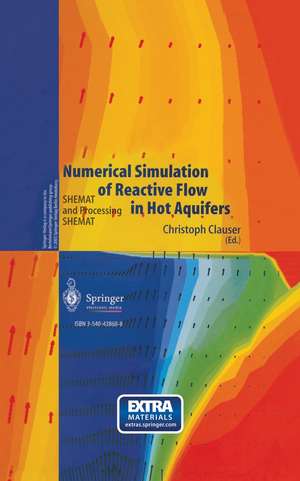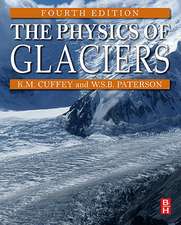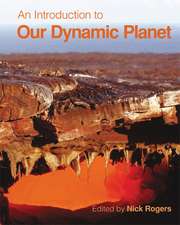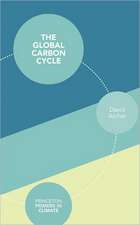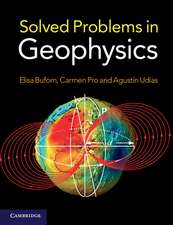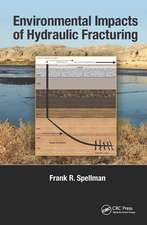Numerical Simulation of Reactive Flow in Hot Aquifers: SHEMAT and Processing SHEMAT
Editat de Christoph Clauseren Limba Engleză Paperback – 11 apr 2014
| Toate formatele și edițiile | Preț | Express |
|---|---|---|
| Paperback (1) | 637.25 lei 6-8 săpt. | |
| Springer Berlin, Heidelberg – 11 apr 2014 | 637.25 lei 6-8 săpt. | |
| Hardback (1) | 572.95 lei 39-44 zile | |
| Springer Berlin, Heidelberg – 28 noi 2002 | 572.95 lei 39-44 zile |
Preț: 637.25 lei
Preț vechi: 749.70 lei
-15% Nou
Puncte Express: 956
Preț estimativ în valută:
121.95€ • 127.16$ • 101.35£
121.95€ • 127.16$ • 101.35£
Carte tipărită la comandă
Livrare economică 20 martie-03 aprilie
Preluare comenzi: 021 569.72.76
Specificații
ISBN-13: 9783642628665
ISBN-10: 3642628664
Pagini: 348
Ilustrații: IX, 332 p. 257 illus., 224 illus. in color.
Dimensiuni: 155 x 235 x 25 mm
Greutate: 0.49 kg
Ediția:2003
Editura: Springer Berlin, Heidelberg
Colecția Springer
Locul publicării:Berlin, Heidelberg, Germany
ISBN-10: 3642628664
Pagini: 348
Ilustrații: IX, 332 p. 257 illus., 224 illus. in color.
Dimensiuni: 155 x 235 x 25 mm
Greutate: 0.49 kg
Ediția:2003
Editura: Springer Berlin, Heidelberg
Colecția Springer
Locul publicării:Berlin, Heidelberg, Germany
Public țintă
ResearchCuprins
1 Introduction.- 2 Numerical Simulation of Reactive Flow using SHEMAT.- 2.1 General.- 2.2 Governing Equations.- 2.2.1 General.- 2.2.1 Ground Water Flow.- 2.2.2 Heat Transport.- 2.2.3 Species Transport.- 2.2.4 Physical Properties.- 2.2.5 Chemical Reactions.- 2.3 Numerical Techniques.- 2.3.1 Finite Difference Method.- 2.3.2 Flow Discretization.- 2.3.3 Discretization Schemes for Transport of Heat and Dissolved Species.- 2.3.4 Equation Solver.- 2.3.5 Time Step Control.- 2.3.6 Process Coupling.- 2.4 Input / Output.- 2.4.1 General Overview.- 2.4.2 Control File.- 2.4.3 Input File.- 2.4.4 Output File.- 2.4.5 Plot Files.- 2.4.6 Output Grid.- 2.4.7 Monitoring Files.- 2.4.8 Run-time Information.- 2.5 Practical Modeling: Remarks, Explanations and Instructions.- 2.5.1 Problem Size.- 2.5.2 Remarks on Flow Input Parameters.- 2.5.3 Boundary Conditions and Wells.- 2.5.4 Time.- 2.5.5 Convergence.- 2.6 Code Verification.- 2.6.1 Theis Problem.- 2.6.2 Rotating Cone Test.- 2.6.3 Henry’s Problem.- 2.6.4 Elder’s problem.- 3 Pre- and Post-Processing with “Processing SHEMAT”.- 3.1 What is Processing SHEMAT?.- 3.1.1 Professional Graphical Data Input Features.- 3.1.2 Sophisticated Modeling Tools.- 3.2 Modeling Environment.- 3.2.1 Units.- 3.2.2 Toolbar.- 3.2.3 Grid Editor.- 3.2.4 Data Editor.- 3.2.5 Value.- 3.2.6 Options.- 3.3 Menu System.- 3.3.1 File.- 3.3.2 Grid.- 3.3.3 Type.- 3.3.4 Time.- 3.3.5 Flow.- 3.3.6 Heat.- 3.3.7 Transport.- 3.3.8 Reaction.- 3.3.9 Models.- 3.3.10 Tools.- 3.3.11 Help.- 4 Advanced Features.- 4.1 Chemical Equilibrium Speciation for Brines at High Temperatures and Ionic Strength.- 4.1.1 Activity calculations.- 4.1.2 Comparison of the Pitzer and Debye-Hückel Models.- 4.1.3 Chemical Module based on Pitzer’s Equations.- 4.1.4 Specification of the Chemical Module.- 4.2 Fractal Relation Between Porosity and Permeability: Theory and Verification.- 4.2.1 Introduction.- 4.2.2 Permeability Derived from Pore Space Models.- 4.2.3 Exponents in the Relationship between Porosity and Permeability Implemented in SHEMAT.- 5 Tutorial for “Processing SHEMAT”.- 5.1 Introduction.- 5.1.1 General Information.- 5.1.2 How to use this Tutorial.- 5.1.3 Description of the Example Problem.- 5.2 Creating a Fluid Flow, Heat Transfer, and Solute Transport Model.- 5.2.1 Generating a New Model.- 5.2.2 Defining the Flow Parameters.- 5.2.3 Defining the Heat Parameters.- 5.2.4 Defining the Transport Parameters.- 5.2.5 Running Models and Visualizing Results.- 5.3 Using the Geochemical Reaction Module.- 5.3.1 General Information.- 5.3.2 Refining the Model Grid.- 5.3.3 Defining the Reaction Parameters.- 5.3.4 Running Geochemical Reaction Models and Visualizing Results.- 5.4 Expanding the Model to Three Dimensions.- 5.4.2 Defining the additional Model Parameters.- 5.4.3 Running 3-D Models and Visualizing Results.- 6 Applications.- 6.1 Development of a Preferential Flow Path in an Anhydrite Cemented Sandstone: Numerical Simulation of a Core Flooding Experiment.- 6.1.1 Problem description.- 6.1.2 Laboratory core flooding experiment.- 6.1.3 Concept and conditions for preferential flow path development.- 6.1.4 Model description and assumptions.- 6.1.5 Results and Discussion.- 6.1.6 Conclusion.- 6.2 Modeling Flooding of a Sandstone Core with Reactive Transport and Subsequent Changes in Porosity and Permeability.- 6.2.1 Problem description and experimental data.- 6.2.2 Model Description and Assumptions.- 6.2.4 Results and Discussion.- 6.3 Injection Well with Reaction Kinetics.- 6.3.1 Problem description.- 6.3.2 Model description and assumptions.- 6.3.3 Results and Discussion.- 6.3.4 Conclusion.- 6.4 Magmatic Intrusions in Long Valley Caldera.- 6.4.1 Long Valley Caldera: introduction and regional setting.- 6.4.2 Model description and assumptions.- 6.4.3 Steady-state Conductive Models.- 6.4.4 Transient Models of Heating and Cooling.- 6.4.5 Discussion.- 6.5 Rhine Graben Cross Section.- 6.5.1 Rhine Graben: Introduction and regional setting.- 6.5.2 Temperature Data Across the Upper Rhine Graben.- 6.5.3 Model description and assumptions.- 6.5.4 Results and Discussion.- 6.5.5 Discussion.- 6.6 Thermal Transect of Continental Lithosphere in Canada.- 6.6.1 Problem description.- 6.6.2 Temperature in the lithosphere: a matter of uncertainty.- 6.6.3 Model description.- 6.6.4 Results and discussion.- 6.7 Waiwera Coastal Geothermal System.- 6.7.1 Problem description.- 6.7.2 Observations.- 6.7.3 Model description and assumptions.- 6.7.4 Results and Discussion.- 6.7.5 Conclusions.- References.
Recenzii
From the reviews:
"The primary audience for this text consists of hydrogeologists and geophysicists. … It aims to provide a systematic introduction to the software SHEMAT … . Overall, the material is well presented. The philosophy of the book, to present the necessary mathematical background … is well thought through. It should be able to fill a dual role of being a user guide and an introduction into the modelling and simulation of flow in hot aquifers." (Ute Mueller, The Australian Geologist, Issue 128, 2003)
"The primary audience for this text consists of hydrogeologists and geophysicists. … It aims to provide a systematic introduction to the software SHEMAT … . Overall, the material is well presented. The philosophy of the book, to present the necessary mathematical background … is well thought through. It should be able to fill a dual role of being a user guide and an introduction into the modelling and simulation of flow in hot aquifers." (Ute Mueller, The Australian Geologist, Issue 128, 2003)
Textul de pe ultima copertă
This product, consisting of a CD-ROM and a book, deals with the numerical simulation of reactive transport in porous media using the simulation package SHEMAT/Processing SHEMAT. SHEMAT (Simulator for HEat and MAss Transport) is an easy-to-use, general-purpose reactive transport simulation code for a wide variety of thermal and hydrogeological problems in two or three dimensions. The book is a richly documented manual for users of this software which discusses in detail the coded physical and chemical equations. Thus, it provides the in-depth background required by those who want to apply the code for solving advanced technical and scientific problems. The enclosed companion CD-ROM contains the software and data for all of the case studies. The software includes user-friendly pre- and post-processors which make it very easy to set up a model, run it and view the results, all from one platform. Therefore, the software is also very suitable for academic or technical "hands-on" courses for simulating flow, transport of heat and mass, and chemical reactions in porous media. You can find a link to the updated software on springer.com .
Caracteristici
User-friendly software on Extra Materials
Rich documented manual
Attractive for practitioners
Includes supplementary material: sn.pub/extras
Rich documented manual
Attractive for practitioners
Includes supplementary material: sn.pub/extras
